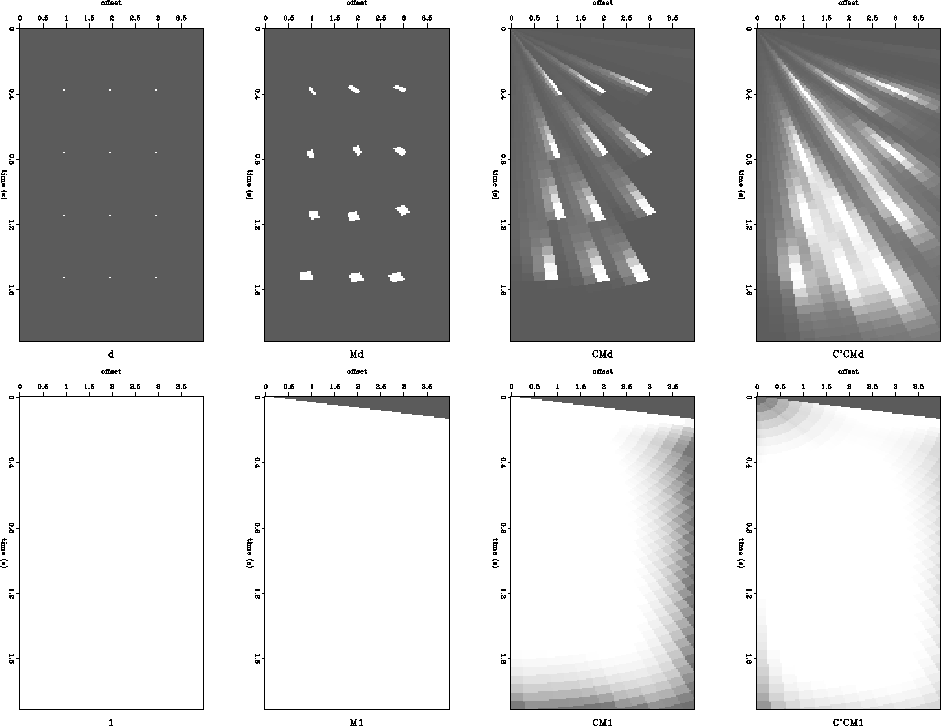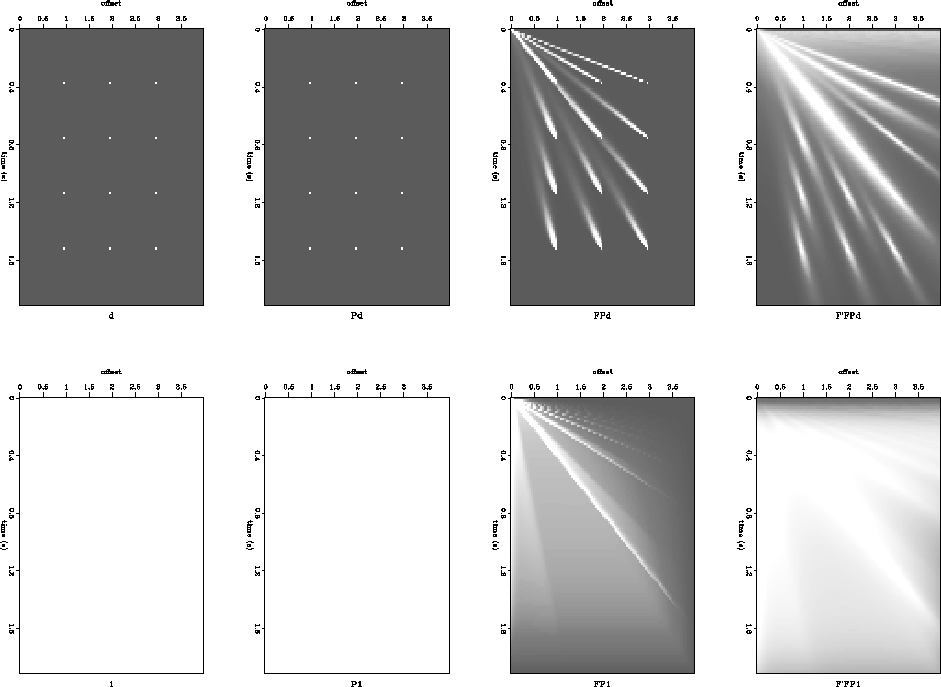We can choose pixel-wise smoothing or micropatch smoothing. An easy argument favoring micropatches over pixel-wise smoothing says that putting a filter at every data sample is a tremendous waste of memory. If the data are predictable at all, they are probably not so nonstationary that they need a separate PEF at each sample. A single 3-D PEF has easily 20 or more adjustable coefficients, so allocating the set of PEFs requires 20 times the storage of the input data. Even very small micropatches require much less memory.
Micropatches also have some
simplifying side effects that make them preferable to
pixel-wise smoothing.
One is apparent from examining Figures curtSmear8 and random8.
Figure curtSmear8 shows smoothing in micropatches and Figure
random8 shows pixel-wise smoothing.
In each figure, the values represent filter coefficients
displayed in data coordinates. The axes are time and offset.
The top halves show a set of impulses, labeled ![]() .
.![]() is the impulses binned into micropatches, while
is the impulses binned into micropatches, while
![]() is the impulses binned into pixels
(naturally,
is the impulses binned into pixels
(naturally, ![]() ).
).
![]() and
and ![]() are pixel-wise smoothers pointed towards
and away from zero radius, respectively.
are pixel-wise smoothers pointed towards
and away from zero radius, respectively.
![]() and
and ![]() are the micropatched smoothers.
In this case, the two are similar, though the pixel-wise smoother
obviously produces a higher-resolution picture (though the
micropatches could be made much smaller).
are the micropatched smoothers.
In this case, the two are similar, though the pixel-wise smoother
obviously produces a higher-resolution picture (though the
micropatches could be made much smaller).
The bottom halves show the same treatment applied to a constant
function, labeled ![]() .
.![]() has an angular limit applied.
Pixel-wise smoothing creates some very large ridge artifacts,
visible in
has an angular limit applied.
Pixel-wise smoothing creates some very large ridge artifacts,
visible in ![]() and
and ![]() ,where the angle between a data sample and the origin corresponds
to an integer slope.
Also, where the constant function is smoothed in towards zero radius,
,where the angle between a data sample and the origin corresponds
to an integer slope.
Also, where the constant function is smoothed in towards zero radius,
![]() , energy concentrates in a huge spike at
the origin.
, energy concentrates in a huge spike at
the origin.
![]() and
and ![]() can be thought of as weighting functions in equation goodleak2
(either
can be thought of as weighting functions in equation goodleak2
(either ![]() or
or ![]() is used for
is used for ![]() in that equation).
It is desirable to have the flatter weighting function.
It is also simpler to implement.
Producing the many different angles in Figure random8
requires that the smoothers
in that equation).
It is desirable to have the flatter weighting function.
It is also simpler to implement.
Producing the many different angles in Figure random8
requires that the smoothers ![]() and
and ![]() be made
up of many different filters, oriented in a continuous sweep
between a spatial derivative and a time derivative.
be made
up of many different filters, oriented in a continuous sweep
between a spatial derivative and a time derivative.
![]() and
and ![]() produce the same range of angles in Figure curtSmear8
using a single, radial derivative filter.
The PEFs in micropatches are regularly gridded in angle and radius,
so they are easily smoothed in those directions with old-fashioned
stationary 1-D derivative filters.
PEFs at every pixel are instead regularly sampled in time and offset,
so working in polar coordinates requires some work.
produce the same range of angles in Figure curtSmear8
using a single, radial derivative filter.
The PEFs in micropatches are regularly gridded in angle and radius,
so they are easily smoothed in those directions with old-fashioned
stationary 1-D derivative filters.
PEFs at every pixel are instead regularly sampled in time and offset,
so working in polar coordinates requires some work.
![]() uses many coefficients,
uses many coefficients, ![]() uses two.
uses two.
 |
 |